
The Olympus IS-5 Deluxe is an all in one SLR zoom, or more commonly known as a ‘bridge’ camera. At first glance it seems like a slightly upgraded version of the IS-30 DLX, reviewed here, the main differences seemingly being the longer zoom and the full manual controls you get with the IS-5. However, both cameras are quite different when compared closely; the bodies, controls, lenses and even the shutter mechanisms are different. With that said, there are some similarities too, but mostly internal like exposure times, shooting modes and flash use.
The Olympus IS-5 is the perfect camera for the hobbyist or advanced amateur that wants complete control over their camera, but without having to bother with changing lenses. This relatively small SLR has all the conveniences and necessities that we demand today for our expensive digital cameras; such as predictive AF, TTL phase-difference detection system; TTL light metering and fuzzy logic ESP metering for back-lit scenes and ±2ev exposure compensation. Also included are; auto advance, rewind and loading; powerful flash with high speed sync; aperture priority mode and a whole lot more.
So is the IS-5 better than the IS-30? Read on and let’s find out!
Name; Olympus IS-5 Deluxe in the USA; IS-5000 elsewhere. Our review model is marked as IS-5 Deluxe 101770.
Manufactured by; Olympus Optical company LTD, Tokyo, Japan.
Made in; China.
Date of manufacture; 2002-.
Price; American Photo ad from 2002 listed as $349.95. Current eBay prices range anywhere from $20 to $75 or more depending on condition and if it comes with the original box or is refurbished etc. I paid less than $40 including shipping for my ‘outfit’.
Build material; appears to be a metal frame with a plastic skin. Fit and finish are ordinary to very good.
Box contents; Camera, soft case, shoulder strap, instruction manual in multiple languages, and some batteries.
Weight; my measurements; camera with batteries, 24.6oz (698g).
Dimensions; my measurements; 5.25″ (130mm) long, 3.4″ (87mm) tall, and 5.3″ (135mm) deep, and 7.25″ (185mm) with lens extended.
Focal length; 28-140mm 5x zoom.
Aperture; F/4.9 maximum at wide end, F/6.9 at the long end. F/22 minimum. Changeable in half stop increments.
ISO; 25-3200 DX coded. Defaults to ISO 32 for non-DX coded film. Settings are: 25, 32, 50, 64, 100, 125, 200, 250, 400, 500, 800, 1000, 1600, 2000, 3200). Other intermediate film speeds are automatically set for the next lower speed.
Focusing distance; 2.0′ (0.6m) to infinity at wide angle and with macro mode at all focal lengths.
Viewfinder; just like a real SLR, and with a -2∼+1 diopter adjustment. Has 85% FOV, and magnification of 0.72 at 50mm. Viewfinder information includes; autofocus frame, spot frame, panorama frame, autofocus indicator, flash indicator (to be used as flash warning), overexposure/underexposure indicator.
Approximate resolution; good film and technique will make very sharp 11×14″ prints. See sample images farther down the page.
Lens; 28-110mm 5x zoom; 15 elements in 10 groups, with a 4 group zoom construction. Has ‘ED’ lens element. Lens cover attached to front of lens and is removable. Uses 52mm filters, B&H, Amazon, eBay.
Shutter and speed; electronic; 1/2000 to 1/15 in auto mode, one minute max in ‘manual’ mode.
Date back; goes to 2032, so Olympus figured the camera would last 30 years!
Film; standard 35mm cartridges.
Flash; capable of variable flash output depending on scene and distance to camera. ‘FP’ short for ‘focal plane’ and twin flash are the same. The camera has a regular flash for wider coverage, and a Syncs at ‘under’ 1/100. Will do up to 1/2000 in ‘portrait’ mode only. Four second recycle time at maximum power, with a claimed guide number of 25; more like 12 at wide angle ISO 100 with regular flash.
Power; two CR123A 3V batteries; B&H, Amazon, eBay.
Accessories for this model; Remote control RC300C, and IS/L Lens E-1.3X H.Q.Teleconverter.
Crippling features and omissions; flash sync too slow, and causes problems when trying to use fill flash at wide apertures and shutter speed above 1/100; however, you can use portrait mode and get high speed sync. Batteries may not be available at normal locations like grocery store etc, plus they’re expensive.
Good features; excellent exposure metering, fast and accurate focusing, and full manual controls.
Quirks; none other than what I mentioned above.
Other versions; there are several other versions of the IS series going back to 1990.
Go here to see the owner’s manual.
Product shots with descriptions. Click pictures for larger versions.
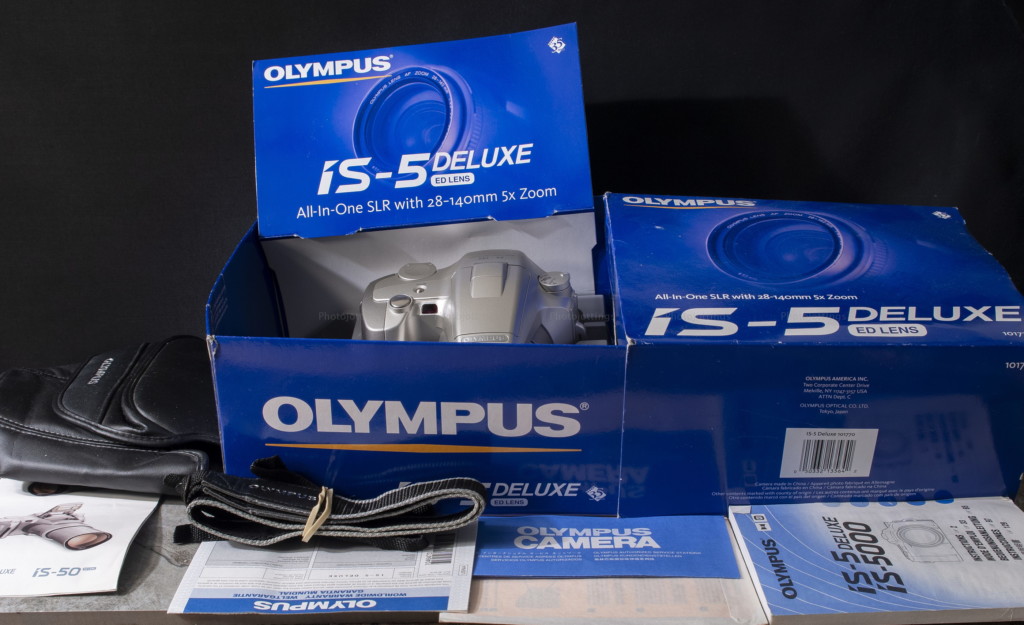
Original camera outfit; camera, vinyl case, neck strap, along with all the literature and manuals.

The Olympus IS-5 uses a spring loaded lens cap that has to be opened and closed manually, and it has to be removed (gently pull to take off) if you plan on using filters.

There isn’t much to see on the left side other than a lone strap lug.
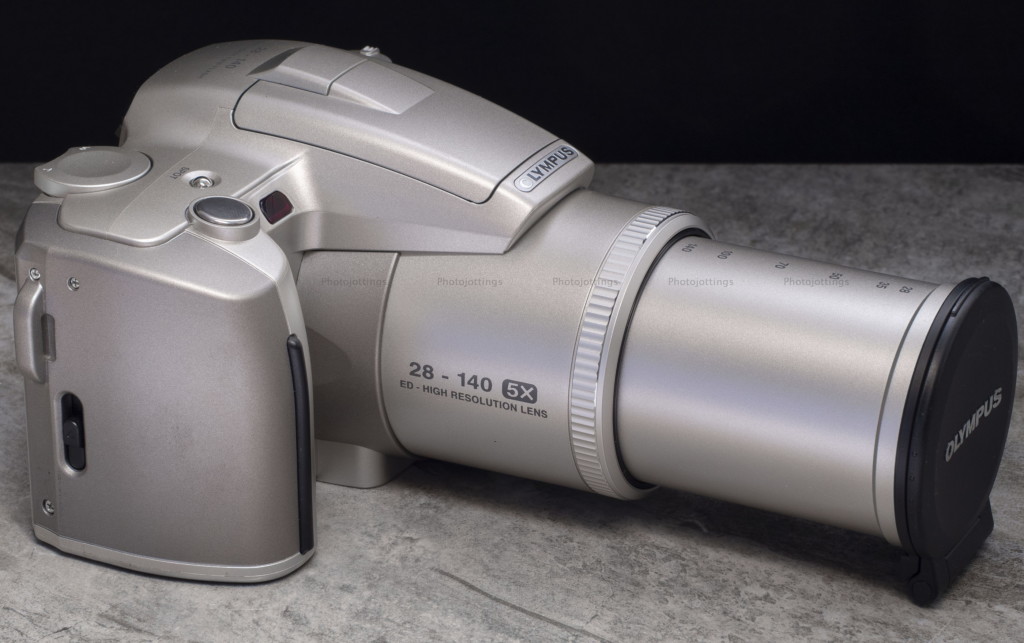
The lens extends about 2.2″ (55mm) at the long end, and is marked with common focal lengths along the barrel. Also, the lens doesn’t rotate, so you can use your polarizers and ND grads with no fuss.

The ‘twin’ flash pops up only when you turn the control dial to the flash setting, and will not pop up automatically in low light. Olympus calls it a ‘twin flash’ and ‘Super FP flash,’ which is confusing, but here’s the gist; the top part of the flash is used at the wider end of the zoom, and the lower part for longer zoom lengths. Super FP or ‘focal plane’ is the same as modern HSS, or high speed sync, and is used for syncing the flash beyond the normal 1/100s maximum: here the flash uses a series of very short duration emissions while the shutter traverses over the frame, however the penalty is a very weak flash, that’s why it only works in ‘Portrait’ mode, and close to your subject.
The small square red panel is for the 12 second self timer, staying solid red for 10 seconds, and flashing the last two seconds before tripping the shutter.

The 28-140mm lens uses an ‘ED’ lens element, and is totally different from the IS-30 DLX lens.

On the back of the camera there are several features to point out: the top left button by the 33mm x 14mm LCD panel controls the flash mode. The second button is used for the self timer, remote control, macro mode and burst shooting. The next button down is for dialing in exposure compensation, hold down and bump the shift lever up or down for a total compensation of -2 to +2. The same button also acts as a shutter speed dial when set to manual mode, and again, you hold down the button and use the shift lever to change shutter speeds. The small square date button opens up the date settings, (up to 2032), and D-M-Y etc order. The bottom button activates the green LCD light.
The orange lamp on the right side of the viewfinder warns you of the idiotic panorama mode. The viewfinder shows guidelines for the panorama, but it doesn’t show any crop. You can turn it on or off for each shot.
The little wheel on the left side of the viewfinder is the diopter adjuster, which corrects for abnormal vision; it goes from -2 to +1. The viewfinder relief is poor, so trying to wear your glasses while peering through the finder is not going to work very well.
The red letter shift button is for selecting exposure modes; manual, aperture and shutter priority. The lever surrounding the shift button is for changing the settings for either the shutter or the aperture in half stop increments.
The large round direct mode panel allows instant access to different program modes. On top is landscape mode, which keeps the aperture stopped down; next on the right is portrait mode, which keeps the aperture open and allows the use of the Focal plane high speed sync flash. The bottom button is for ‘stop action’ shooting and uses a high shutter speed. On the left is the ‘night scene’ mode, which is normally used with the flash and keeps the subject from being ‘overly’ illuminated.
Lastly, the zoom switch is on the top right, and it takes about 3 seconds to zoom from 28mm to 140mm.
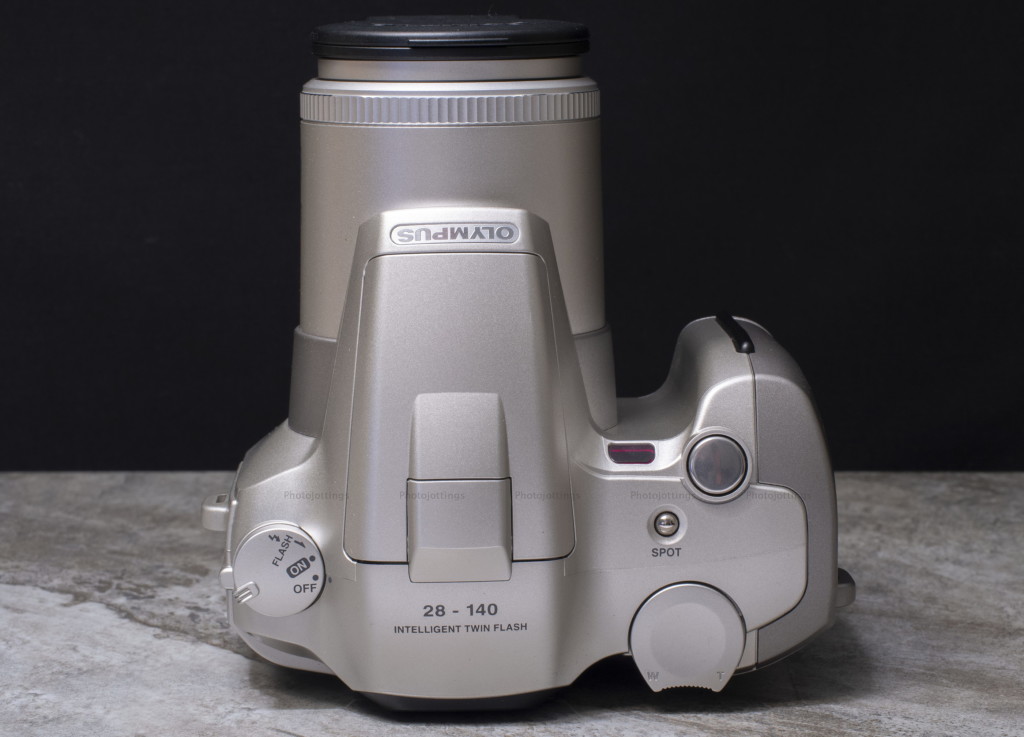
The top has a control dial on the left side for power on, off and flash pop-up. The little silver ball bearing looking button is for spot metering, and the shutter is the large silver button towards the front.
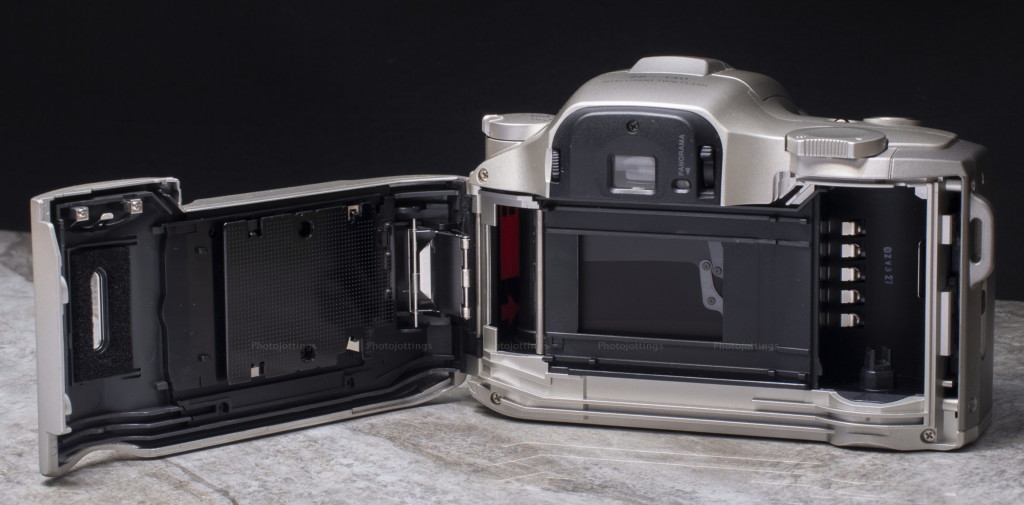
Inside the back cover looks very similar to an SLR. Here you’ll find a metal pressure plate, film reminder window, and a vertical traversing focal plane shutter; don’t touch the blades!!

Here we can see the battery compartment that accepts 2 CR123A batteries; a mid-roll rewind button to the right, and an off-center tripod socket in an anti-spin grip pad.

Olympus sold a teleconverter for the camera; it extends the zoom 1.3x or to 182mm; which is not much, and probably more of a money making gimmick than a thoughtful and requested accessory. On the other side, there is an RC-300C remote control which is actually useful, and very inexpensive; I bought the one here brand new for $5 and the battery was still good!

Here’s how goofy the camera looks with the (IMHO) useless teleconverter attached; however, it actually works ok. You can use filters, which go between the camera lens and converter.
Sample shots below.
Here are a few samples for your viewing pleasure. They’re around 4000 pixels wide, so click image for a larger version. Scanned on a Nikon Coolscan 9000 ED.

Wow, look at the crooked horizon, I guess I got fooled by the immediate terrain incline. F/8, 28mm. Fuji Velvia 100
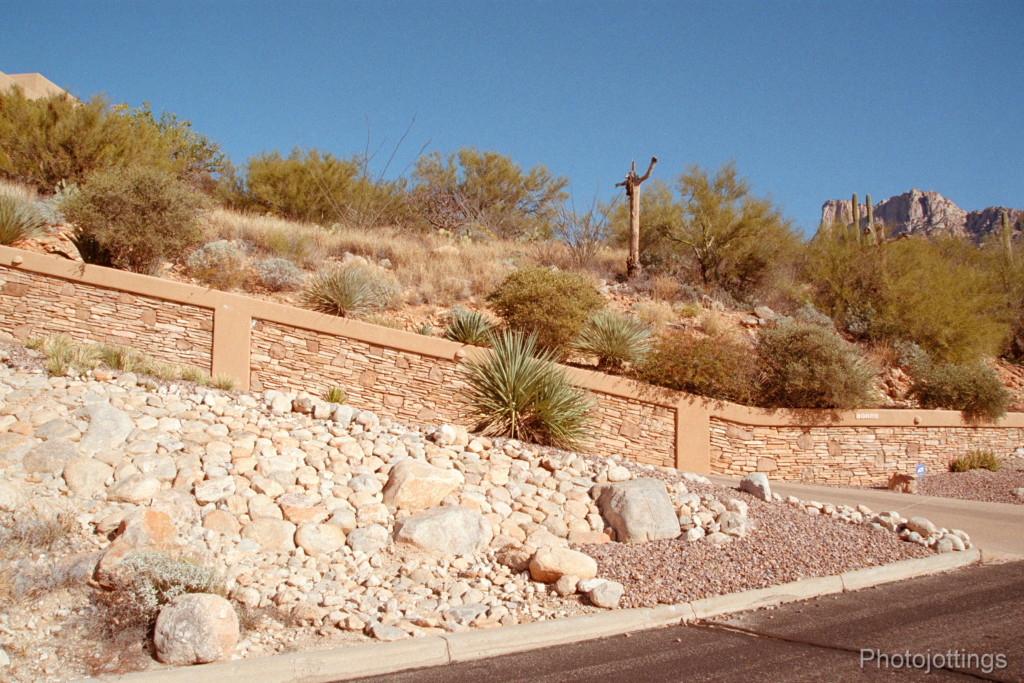
Neat stacked stone wall. F/11, 28mm. Kodak Gold 200.

Close-up of flower. 140mm, F/8? Kodak Portra 400.
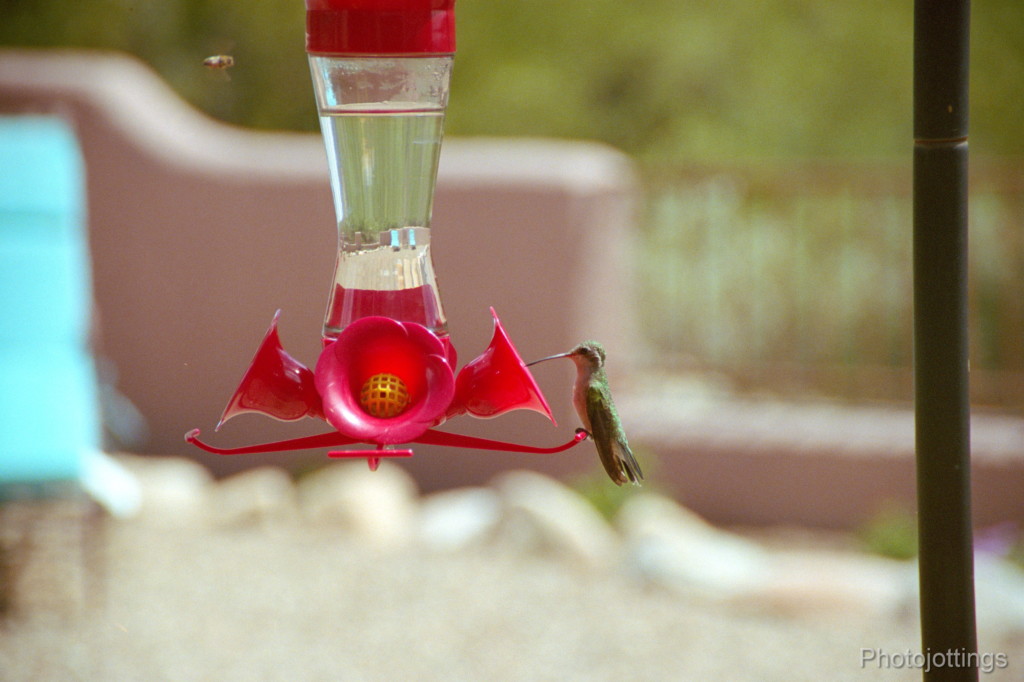
Teleconverter, 182mm. F/8? Bar at right is the feeder hanger. Kodak Portra 400.

New strip mall in Lahaina. Taken at 28mm, about F/8. Fuji Velvia 100

Beach walk. Around 28mm, and F/5.6. Fuji Velvia 100
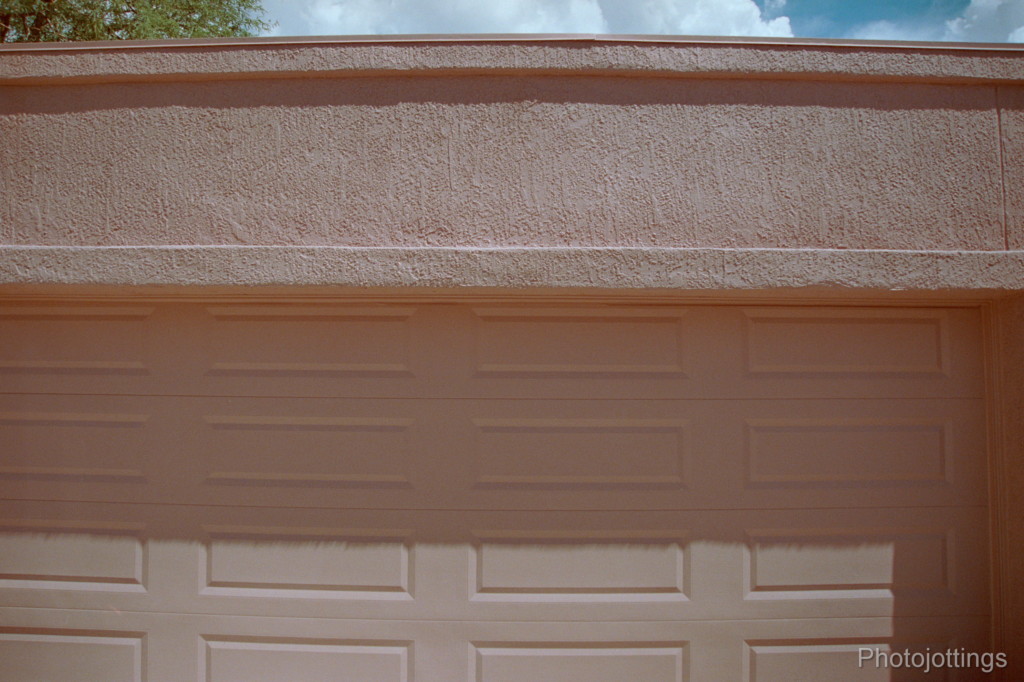
Moderate to strong barrel distortion at 28mm.
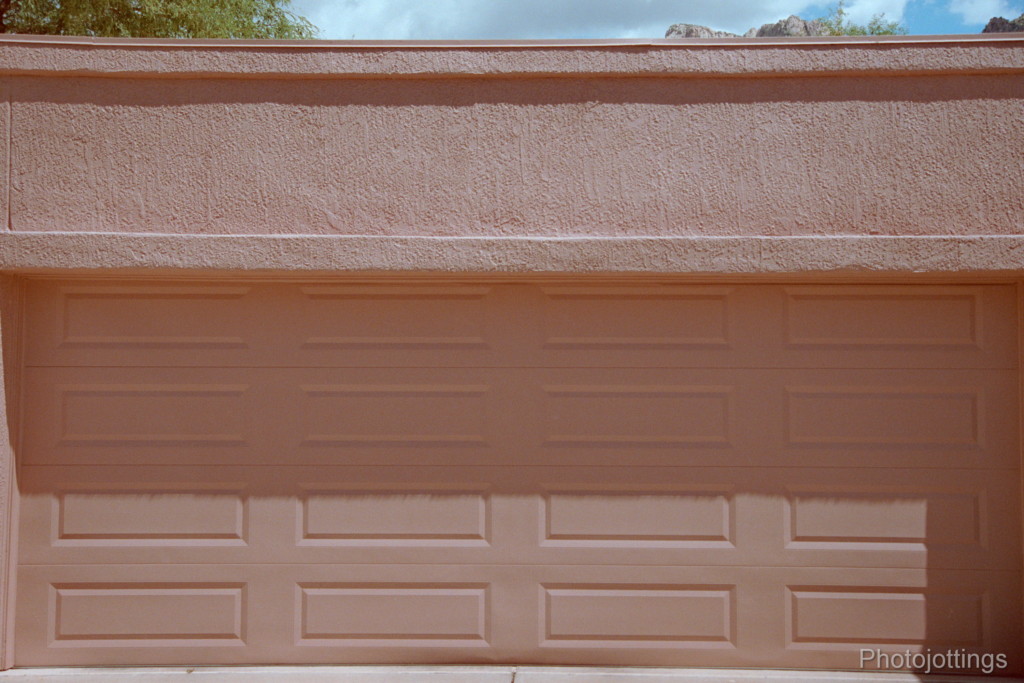
Minor to moderate pincushion distortion at 50mm.
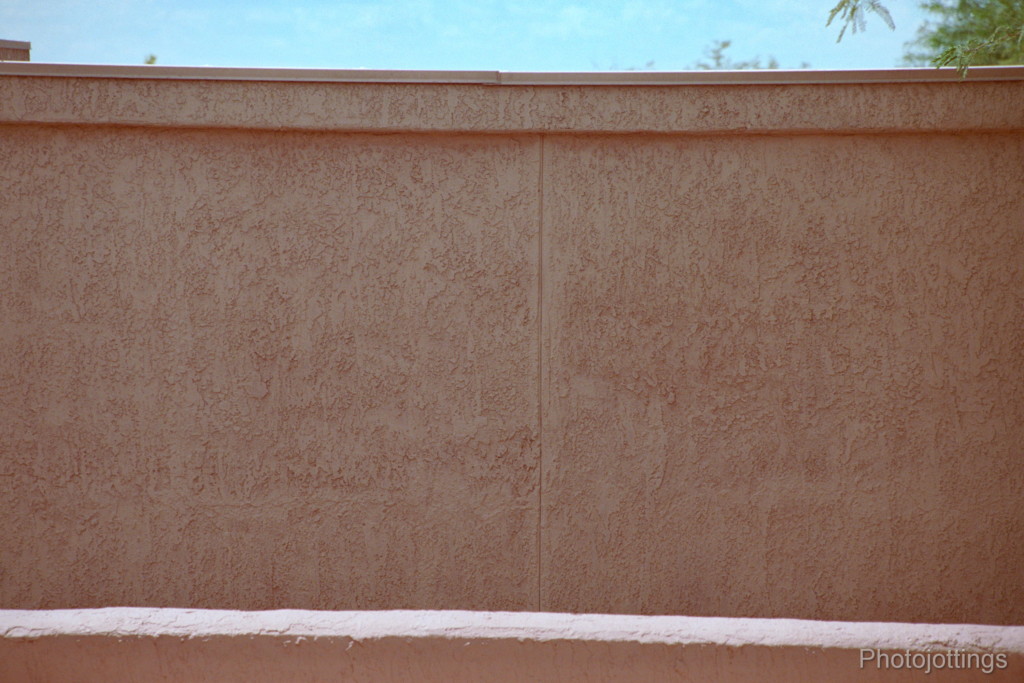
Moderate to heavy pincushion distortion at 140mm.
Test scene below.
All test shots are displayed at approximately 4000 x 2667 pixels wide when enlarged, and that’s all the resolution included in the film. Scanned on a Nikon Coolscan 9000 ED. Tripod used, no filters.
28mm
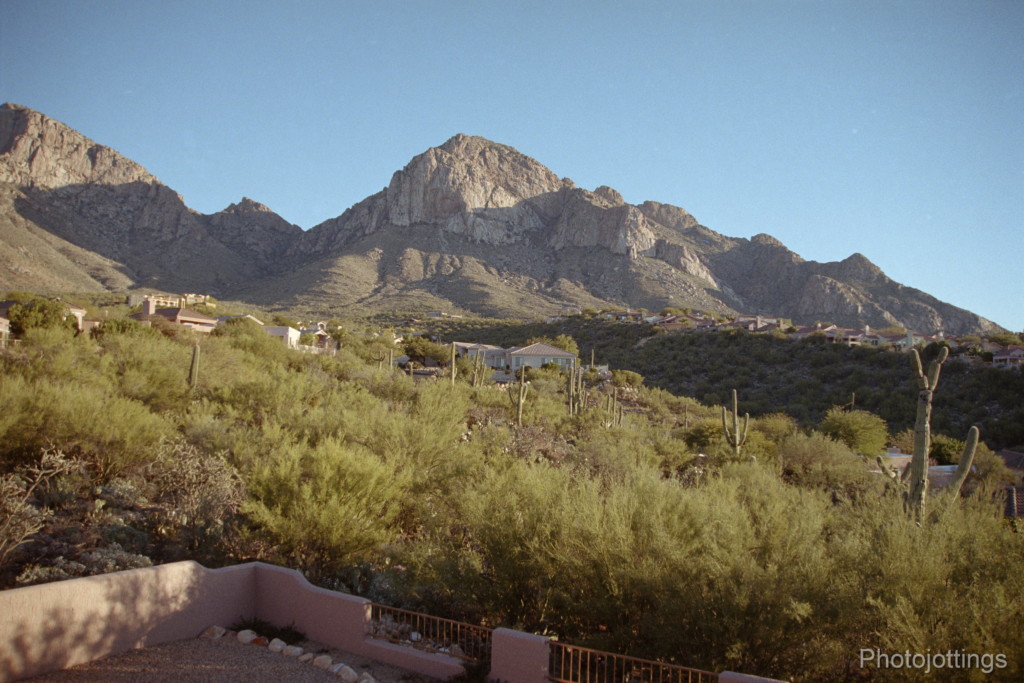
F/4.9. Sharp with good contrast over the whole central area, a little soft along the sides, especially the left side. Heavy light fall-off is noticeable.

Moving to F/8 gets rid of the light fall-off, but the sharpness seems to be a bit less, probably a mistake on my part, and not the fault of the lens.

F/11. The center and sides are pretty sharp, and the best landscape aperture.
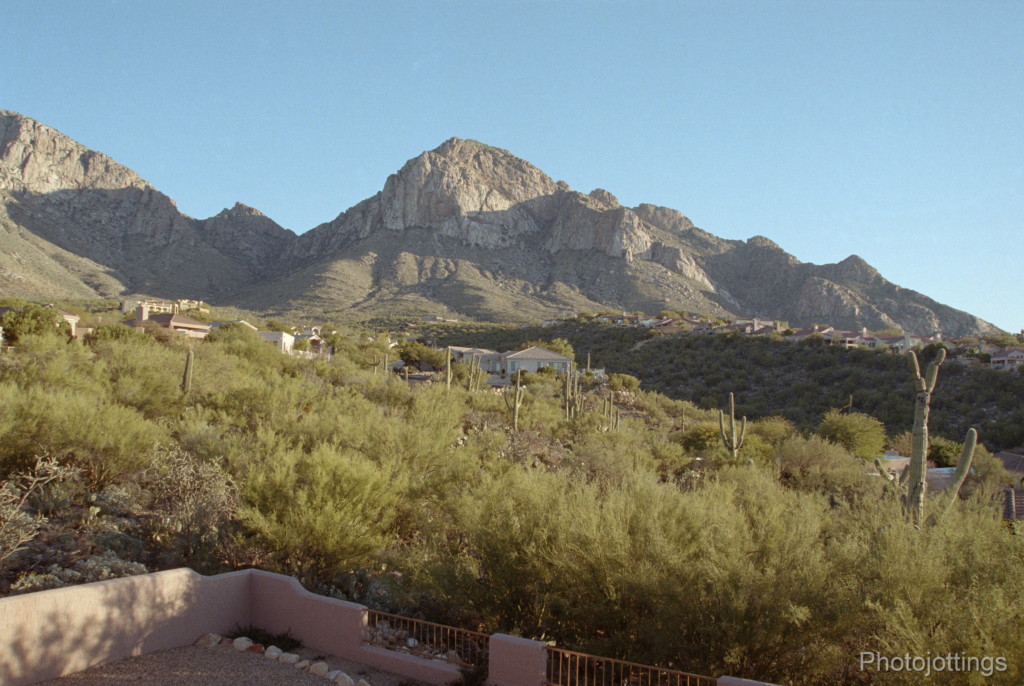
F/16, slight dulling diffraction over the frame, but it still looks sharp.
50mm

At F/5.6 the whole image is quite sharp, with good contrast too.

F/8, a small bump up in sharpness throughout the image.

F/11, about the same as F/8.

F/16, dulling diffraction starts to kick in at this aperture.
140mm

F/6.9, pretty sharp all over, with heavy light fall-off in the corners.

F/8, a minor bump up in sharpness, and less light fall-off.

F/11, about the same as F/8 without the light fall-off.

F/16, about the same as F/11. Landscape scenes are good from F/8-16. Contrast looks pretty good on the long end, and improvement to the lens on the IS-30 DLX.
Conclusion.
The Olympus IS-5 Deluxe turned in a very good review, just like the similar IS-30 DLX. Both cameras are quick to focus, meter pickey slide film correctly, and produce sharp images at all focal lengths, however, for best results, they need to be stopped down to about F/11 if you’re planning on making large prints.
One problem I did have with the IS-5 is that I couldn’t seem to hold the camera steady when zoomed out to 140mm, I guess i’m too shaky for those telephoto shots; although I didn’t have that problem with the IS-30 and the 110mm zoom length.
The IS-5 has full manual controls, which includes shutter speed too, (something the IS-30 doesn’t have) but I really didn’t need to manually change it as I kept the camera in aperture priority mode, just like when I used the IS-30. Both cameras are very easy to use, and are quite small; they won’t fit in a pocket, but a small waist pack is all you need.
That’s it for the Olympus IS-5 Deluxe review, a really nice camera for about the price of a haircut and McDonald’s meal, and don’t forget to choose some film here.
Please consider buying through my links and help support the site. Thanks for visiting!